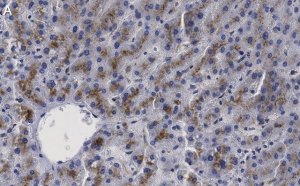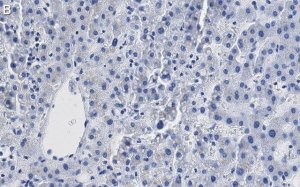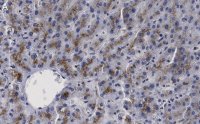- Производитель:
- Sigma-Aldrich
| Кат. номер |
| ZRB1325-4X25UL |
| ZRB1325-25UL |
Each ZooMAb® antibody is manufactured using our proprietary recombinant expression system, purified to homogeneity, and precisely dispensed to produce robust and highly reproducible lot-to-lot consistency. Only top-performing clones are released for use by researchers. Each antibody is validated for high specificity and affinity across multiple applications, including its most commonly used application. ZooMAb® antibodies are reliably available and ready to ship when you need them.
Quality Control Testing
Evaluated by Western Blotting in LNCap cell lysate.
Western Blotting Analysis: A 1:1,000 dilution of this antibody detected -Glucocerebrosidase in LNCap cell lysate.
Tested applications
Western Blotting Analysis: A 1:1,000 dilution from a representative lot detected -Glucocerebrosidase in HeLa cell lysate.
Immunohistochemistry (Paraffin) Analysis: A 1:100 dilution from a representative lot detected -Glucocerebrosidase in human liver and human pancreas tissue sections.
Immunocytochemistry Analysis: A 1:100 dilution from a representative lot detected -Glucocerebrosidase in LNCaP cells.
Affinity Binding Assay: A representative lot of this antibody bound -Glucocerebrosidase peptide with a KD of 1.0 x 10-12 in an affinity binding assay.
Note: Actual optimal working dilutions must be determined by end user as specimens, and experimental conditions may vary with the end user
Target description
Lysosomal acid glucosylceramidase (UniProt: P04062; also known as EC:3.2.1.45; Lysosomal acid GCase, Acid beta-glucosidase, Alglucerase, Beta-glucocerebrosidase, Beta-GC, Cholesterol glucosyltransferase, SGTase, Cholesteryl-beta-glucosidase, D-glucosyl-N-acylsphingosine glucohydrolase, Imiglucerase) is encoded by the GBA (also known as GC, GLUC) gene (Gene ID: 2629) in human. -Glucocerebrosidase is a peripheral membrane glycoprotein that catalyzes the hydrolysis of glucosylceramide/GlcCer into free ceramide and glucose in the lysosomal compartment. It is shown to be maximally active at pH 5.5. Within the lysosome, it remains associated with the membrane, where it binds and degrades its substrate. Its interaction with saposin-C is reported to promote its membrane association. It plays a key role in the degradation of complex lipids and the turnover of cellular membranes. Through the production of ceramides, it participates in the PKC-activated salvage pathway of ceramide formation. It is also reported to plays a role in cholesterol metabolism and can catalyze the glucosylation of cholesterol, through a transglucosylation reaction that transfers glucose from glucosylceramide to cholesterol. Mutations in GBA gene are shown to cause Gaucher disease, a lysosomal storage disease characterized by accumulation of glucosylceramide in the reticulo-endothelial system. GBA mutations are also shown to be the strongest known risk factor for the development of Parkinson s disease. Five isoforms of -Glucocerebrosidase have been described that are produced by alternative splicing. This ZooMAb® recombinant monoclonal antibody, generated by our propriety technology, offers significantly enhanced specificity, affinity, reproducibility, and stability over conventional monoclonals.
Physical form
Purified recombinant rabbit monoclonal antibody IgG, lyophilized in PBS with 5% Trehalose, normal appearance a coarse or translucent resin. The PBS/trehalose components in the ZooMAb formulation can have the appearance of a semi-solid (bead like gel) after lyophilization. This is a normal phenomenon. Please follow the recommended reconstitution procedure in the data sheet to dissolve the semi-solid, bead-like, gel-appearing material. The resulting antibody solution is completely stable and functional as proven by full functional testing. Contains no biocide or preservatives, such as azide, or any animal by-products. Larger pack sizes provided as multiples of 25 μL.
Reconstitution
300 μg/mL after reconstitution at 25 μL per vial. Please refer to guidance on suggested starting dilutions and/or titers per application and sample type.
Storage and Stability
Recommend storage of lyophilized product at 2-8°C; Before reconstitution, micro-centrifuge vials briefly to spin down material to bottom of the vial; Reconstitute each vial by adding 25 μL of filtered lab grade water or PBS; Reconstituted antibodies can be stored at 2-8°C, or -20°C for long term storage. Avoid repeated freeze-thaws.
Disclaimer
Unless otherwise stated in our catalog or other company documentation accompanying the product(s), our products are intended for research use only and are not to be used for any other purpose, which includes but is not limited to, unauthorized commercial uses, in vitro diagnostic uses, ex vivo or in vivo therapeutic uses or any type of consumption or application to humans or animals.
| Quality Level | 200 |
| biological source | rabbit |
| recombinant | expressed in HEK 293 cells |
| antibody form | purified antibody |
| antibody product type | primary antibodies |
| clone | 2I15, recombinant monoclonal |
| description | recombinant, expressed in HEK 293 cells |
| product line | ZooMAb® |
| form | lyophilized |
| mol wt | calculated mol wt 59.72 kDa","observed mol wt ~60 kDa |
| species reactivity | human |
| species reactivity (predicted by homology) | monkey, porcine |
| packaging | antibody small pack of 25 µL |
| enhanced validation | recombinant expression |
| application(s) | affinity binding assay: suitable","immunocytochemistry: suitable","immunohistochemistry (formalin-fixed, paraffin-embedded sections): suitable","western blot: suitable |
| isotype | IgG |
























































































































































